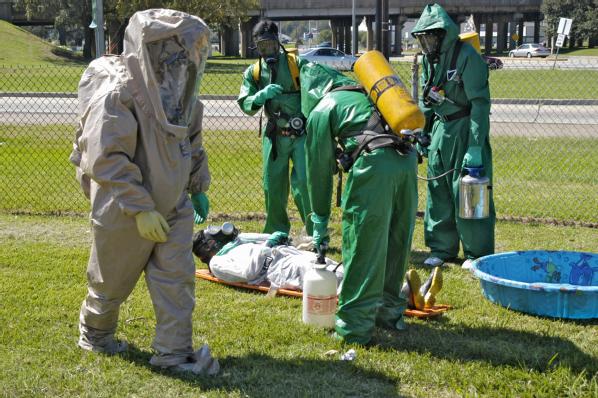Information Sharing Success: Radiological sensor info sharing through collaboration and common standards
Posted by Basil "Nick" Harris, PM-ISE Chief of Staff on Monday, August 22, 2011Due to the popularity of this story, you can now download a PDF about this success story: Global Nuclear Detection Architecure.
Ten years ago, a radiological sensor was triggered in a cargo storage facility at LAX International Airport. After donning the appropriate multi-layered, Level A Hazmat suits, responders entered the facility to measure the amount of radiological material present. While looking through multiple face shields in a foggy, poorly lit area, a responder misread his meter’s reading by a decimal point. He saw a false positive for a nuclear event that resulted in a response of significant stress, risk, time, money, and operational impact to one of the world’s busiest airports. (Image at right depicts FEMA Hazmat training.)
A Much Improved System Today
That same scenario would not occur today. Interagency emergency responders, managers, and leaders in the Los Angeles region have created a culture and policy to employ technology to share chemical, biological, radiological, nuclear, and explosive alarm data with each other. Now, a wide range of legacy sensors are connected by a wireless network, sharing real-time information with responders and operations centers at every level of government to enhance decision making and response capabilities.
DNDO's Demo
PM-ISE recently had the opportunity to partner with the Domestic Nuclear Detection Office (DNDO), and we were excited to attend their demonstration of their ability to connect standardized radiological/nuclear alarm data and detectors among federal, state, and local participants of the Global Nuclear Detection Architecture.
The culmination of this partnership was a live demonstration with participants including twelve Los Angeles-based government agencies, the Kansas City Regional Terrorism Early Warning Group (KCTEW-Fusion Center), DNDO’s Joint Analysis Center, CBP’s PRIDE system, and the Defense Threat Reduction Agency. Observers in Virginia viewed live operational displays from Los Angeles, Kansas City, CBP, and DNDO simultaneously, to follow a scenario in which law enforcement, intelligence, and cargo screening test data was shared in response to a simulated threat.
Info Sharing and Common Data Standards
This information sharing prototype was developed by using common data standards and an available technology solution. DNDO identified a commercially available technology, initially deployed in the banking industry that shares millions of transactions per second through a secure hardware data appliance. Critical to the demonstration’s success was DNDO using information sharing standards such as the National Information Exchange Model (NIEM), OASIS, and ANSII, as a means to establish connectivity between thousands of different detectors nationwide. (The image at right depicts a US Coast Guard center.)
Live instrument (meter) readings can now appear on myriad viewer applications around the country as direct replicas of the equipment deployed in the field. Map interfaces can alert operators with visual displays of alarm information and provide web links to more detailed information. Information is integrated into NIEM conformant standards and routed, as appropriate, to other systems and users in their familiar format.
By connecting detectors to fusion centers, first responders, operations centers, and other mission partners, the effectiveness of the detection equipment is increased, redundant inspections can be eliminated, and the flow of commerce can be maintained. By connecting the nation’s detection equipment through the Global Nuclear Detection Architecture (GNDA), our partnership and collaboration with federal, state, and local participants proved that standardized, whole-of-government, real-time radiological and nuclear alarm data sharing is possible, cost effective, lessens the risk to responders, and improves situational awareness among operational decision makers and responders, regardless of location, data language, or viewer.
Connect with ISE: Comment on Facebook. Sign up for email updates. Send us an email.












